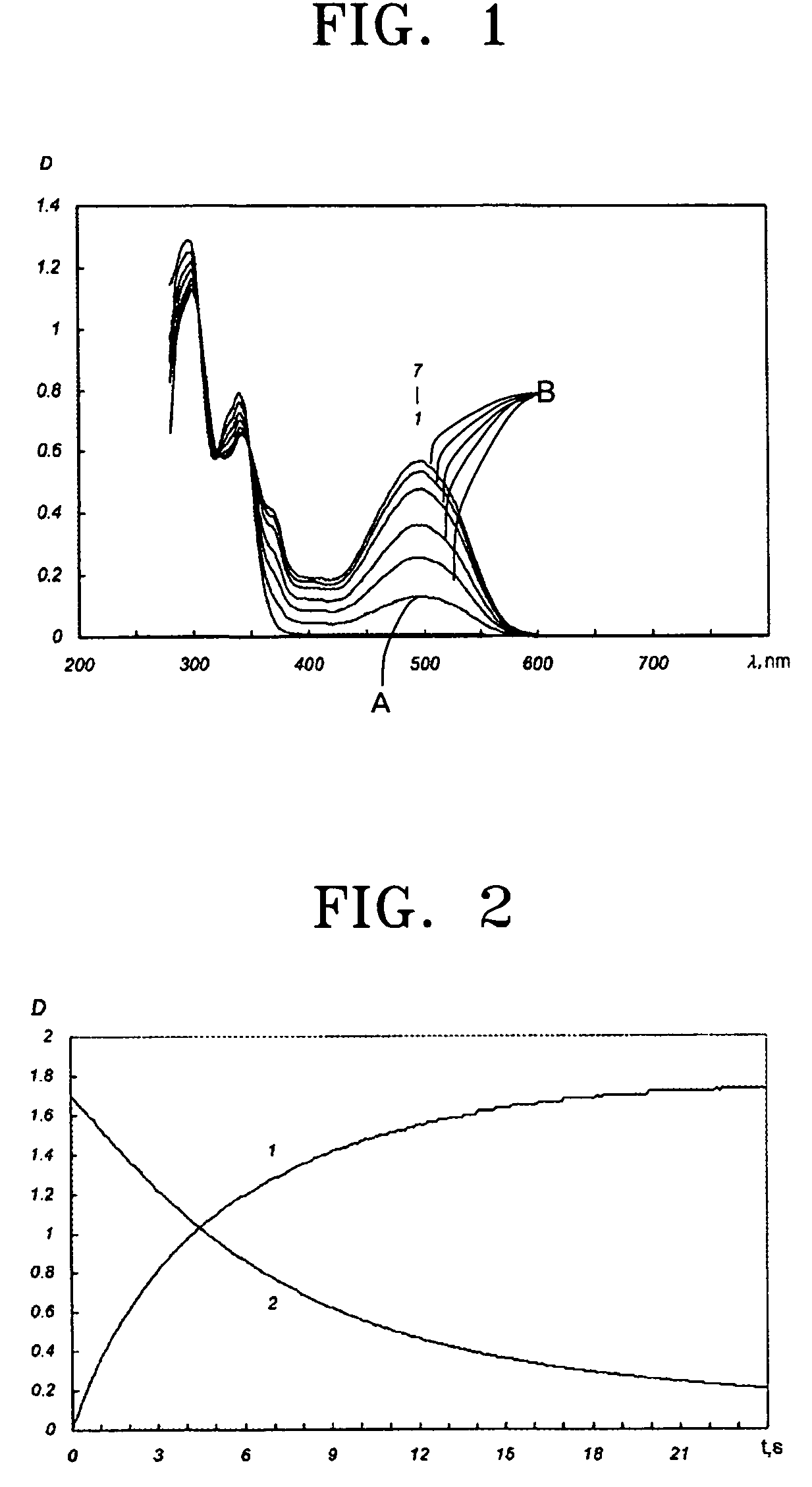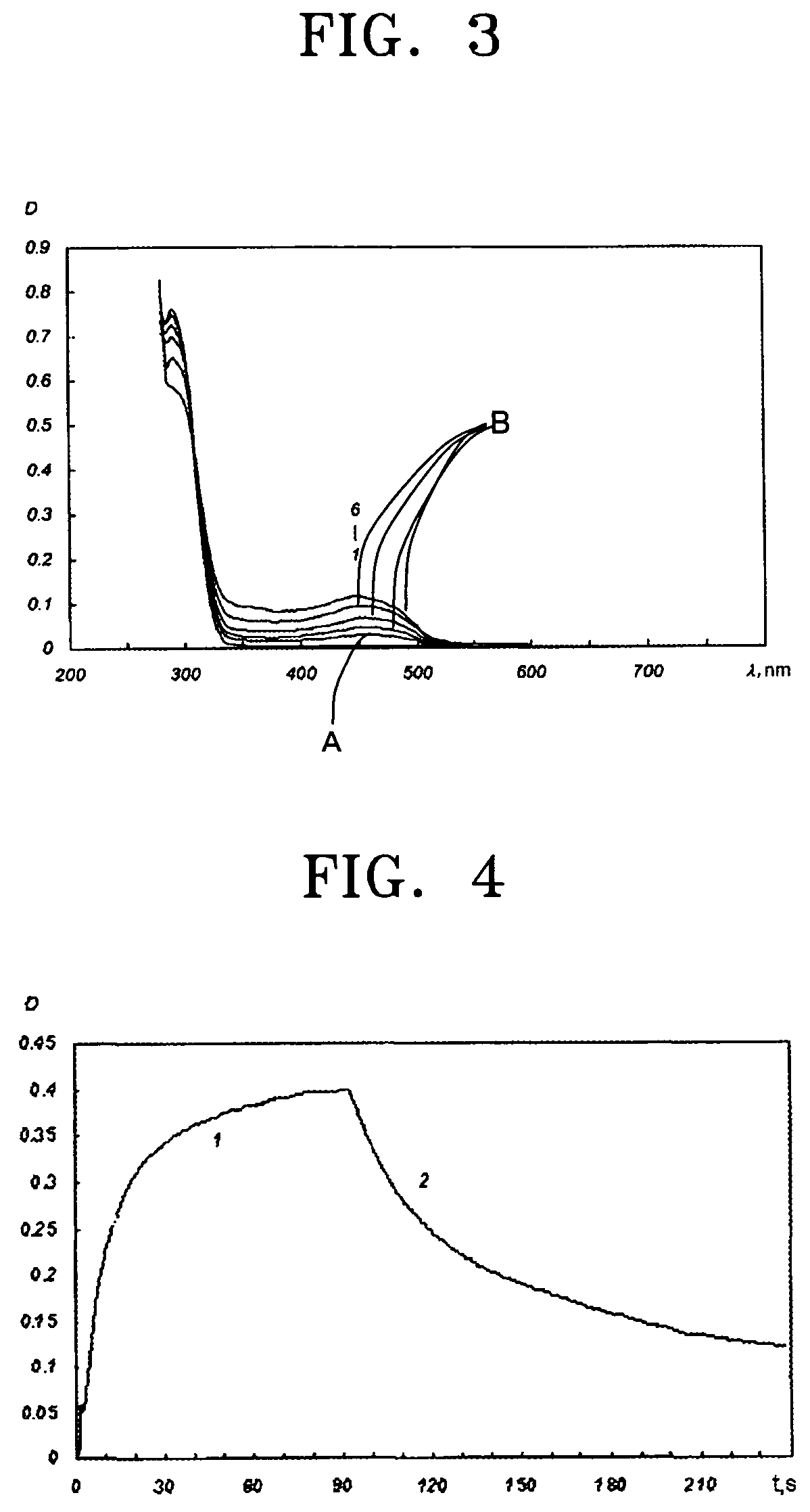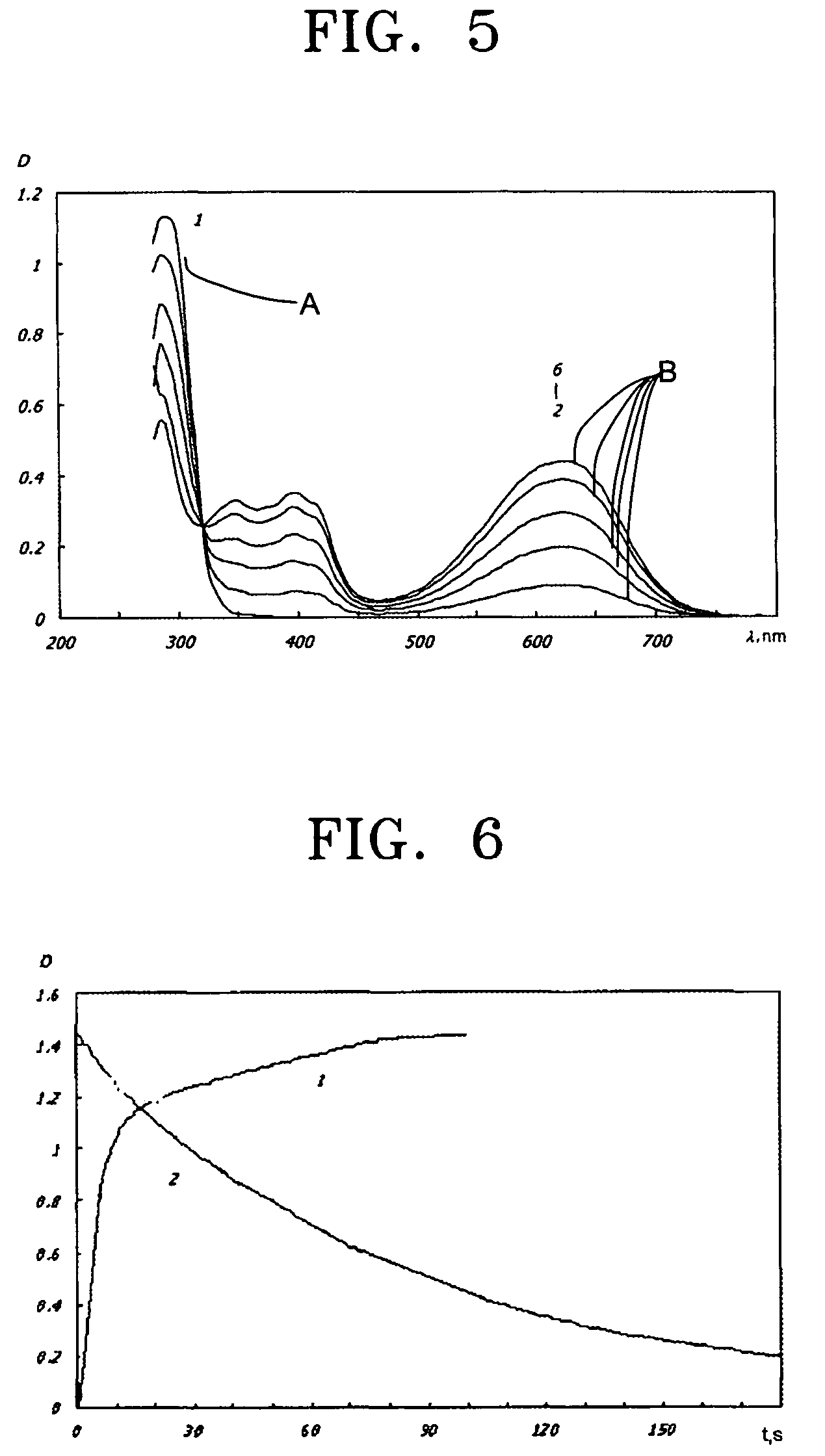Photochromic monomers, photochromic polymers based on the same, photochromic recording media comprising the photochromic polymers, and 3D read/write optical memory comprising the recording media
a photochromic polymer and monomer technology, applied in the field of new photochromic monomers, can solve the problems of limited choice of starting reagents, the preparation of photochromic layers, and the creation of data bases for telecommunication systems
- Summary
- Abstract
- Description
- Claims
- Application Information
AI Technical Summary
Benefits of technology
Problems solved by technology
Method used
Image
Examples
example 1
[0144]A photochromic 1,2-bis(2-methyl-6-formyl-1-benzothiophen-3-yl)cyclopentene monomer 5 of the type I was synthesized according to the scheme shown below:
[0145]
[0146]The method is characterized in that a compound 4 was produced at a yield of 60% by cyclization of diketone 3 under effect of TiCl4 and Zn in THF (tetrahydrofurane) in the presence of pyridine. In contrast, existing literature reports about production of a compound 4 by cyclization of the diketone 3 under effect of TiCl4, Zn in THF is a yield of 54% (Synthesis 1998, pp. 1092-1094).
Synthesis of 1,2-bis(2-methyl-1-benzothiophen-3-yl)cyclopentene 4
[0147]TiCl4 (2.8 ml) was added dropwise to a vigorously stirred suspension of 3.33 g of zinc in freshly distilled anhydrous THF (50 ml) at −10° C. under argon. Upon the addition, the reaction mixture was heated under argon for 1 hour. The mixture was then cooled down to 20° C. and 5.0 g of diketone 3 and anhydrous pyridine (5 ml) were added thereto. The mixture was boiled more ...
example 2
[0152]A photochromic 3-allyl-4,5-bis-(2,5-dimethyl-3-thienyl)-1,3-oxazole-2-one monomer 8 of the type 11 was prepared according to the scheme shown below:
[0153]
Synthesis of 3-allyl-4,5-bis-(2,5-dimethyl-3-thienyl)-4-hydroxy-1,3-oxazolane-2-one 7
[0154]Allylamine (0.3 g, 5.00 mmol) was added to a solution of carbonate 6 (1.0 g, 3.27 mmol) in 10 ml of ethanol and the mixture was stirred at ˜25° C. for 1-1.5 hours. A precipitate was filtered out, and the product was crystallized from ethanol. The yield was 1,1 g (93%) of oxazolane 7, Tmelt=181-182° C. The results found (%): C, 59.54; H, 5.71; S, 17.55. C18H21NO3S2. The results calculated (%): C, 59.48; H, 5.82; S, 17.64. 1H NMR spectrum (DMSO-d6, δ, ppm): 1.79 (s, 3H, CH3); 2.13 (s, 3H, CH3); 2.29 (s, 3H, CH3); 2.36 (s, 3H, CH3); 3.65 (d, 2H, CH2, J=6 Hz); 5.05 (d, 1H, CH, J=10 Hz); 5.11 (d, 1H, CH, J=17 Hz); 5.35 (s, 1H, CH); 5.83 (m,1 H, CH); 6.42 (s,1 H, OH); 6.61 (s,1 H, CH); 6.80 (s,1 H, CH).
Synthesis of 3-allyl-4,5-bis-(2,5-dimeth...
example 3
[0158]A photochromic 1,2-bis(5-hydroxymethyl-2-methylthien-3-yl)hexafluoropentene monomer 12 was synthesized according to the scheme shown below:
[0159]
[0160]This method is characterized in that a more available 1,2-dihydropyrane was used as a protecting group in the synthesis of 1,2-bis(5-hydroxymethyl-2-methylthiophen-3-yl)hexafluoropentene 12. In contrast, existing literature reports of the use of hardly available tert-butyldimethylsilyl protection (Chem. Letters 1998, pp. 1093-1094).
Synthesis of 2-[(4-bromo-5-methylthiophen-2-yl)methoxy]tetrahydro-2H-pyrane 10
[0161]2.6 ml of 1,2-dihydropyrane and 0.2 g of p-toluene sulfonic acid were added to 5.4 g of 4-bromo-2 hydroxymethyl-5-methylthiophene 9 in 40 ml of methanol. The reaction mixture was stirred at room temperature for 24 hours. Methanol was distilled under vacuum and the remainder was distilled by an oil pump. The yield was 6.82 g of the product 10 (90%), Tmelt=125-130° C. (5 mm Hg), nd165=1.5610. Mass-spectrum, m / z: 291, [M]...
PUM
| Property | Measurement | Unit |
|---|---|---|
| temperature | aaaaa | aaaaa |
| optical density | aaaaa | aaaaa |
| optical density | aaaaa | aaaaa |
Abstract
Description
Claims
Application Information
 Login to View More
Login to View More - R&D
- Intellectual Property
- Life Sciences
- Materials
- Tech Scout
- Unparalleled Data Quality
- Higher Quality Content
- 60% Fewer Hallucinations
Browse by: Latest US Patents, China's latest patents, Technical Efficacy Thesaurus, Application Domain, Technology Topic, Popular Technical Reports.
© 2025 PatSnap. All rights reserved.Legal|Privacy policy|Modern Slavery Act Transparency Statement|Sitemap|About US| Contact US: help@patsnap.com



